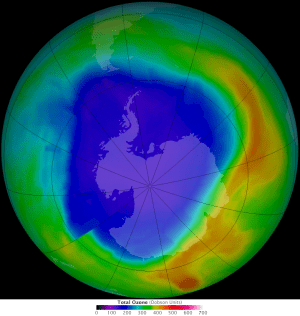
This image shows ozone concentrations over the South Pole on Sept. 16, 2013, as measured by NASA's Aura Earth observation satellite.
The ozone hole over Antarctica was slightly smaller in 2013 than the average for recent decades, according to data from NASA's Aura satellite and the NASA-NOAA Suomi NPP satellite.
The average size of the hole from September“October 2013 was 21 million square kilometers (8.1 million square miles). The average size since the mid 1990s is 22.5 million square kilometers (8.7 million square miles).
The single-day maximum area reached 24 million square kilometers (9.3 million square miles) on Sept. 16”an area about the size of North America. The largest single-day ozone hole ever recorded by satellite was 29.9 million square kilometers (11.5 million square miles) on Sept. 9, 2000.
Image courtesy of NASA.

